Whether you’re keeping a 12-pack cool through a day at the beach or making sure your supplies stay fresh through a weekend camping trip, you’re going to need a cooler you can count on. The best coolers can keep their contents cool for a full day (or even two); are easy to load, carry and clean; and stand up to the rigors of camping, beach trips and weekend barbeques.
To help you pick the best cooler for your picnic, camping trip, or day at the beach, we picked out 17 of the most popular hard, soft, and wheeled coolers, filled them full of ice and drinks, and put them through their paces. We judged them on their overall usability, build quality, installed wireless temperature sensors and assessed just how long each can maintain their internal temperature, and looked as any additional features users might find valuable. After comparing all of our data and results, we’ve found four great options to keep your stuff cool, whatever your needs and budget.
The best hard cooler
A solid, heavy-duty cooler that’s built to last, this Yeti model kept things cold for two full days in our testing, is durable enough to stand up to serious abuse and has enough room to hold 28 cans with plenty of ice.
The best soft cooler
Designed for maximum portability, this 4-pound RTIC soft cooler features multiple convenient carrying options and a heavy-duty nylon shell is durable enough for any outdoor adventure.
The best cooler on a budget
While it’s not bear proof like fancy rotomolded coolers, the low-cost Igloo cooler held its temperature nearly as well in testing, and is sturdy enough to use as a bench at your picnic.
The best wheeled cooler
It’s not cheap, but this heavy-duty cooler is built like a tank, kept its internal temperature extremely well, and despite the bulky size, is comfortable for nearly anyone to wheel and maneuver.
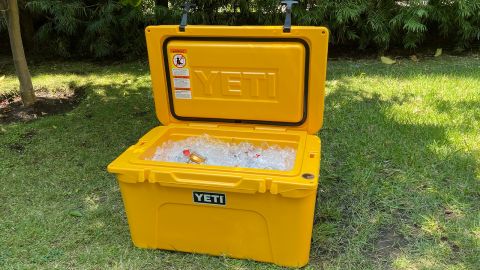
If you’re looking for a solid, all-purpose cooler that’s easy to use, keeps your food cold for a long time, and is built with long-term durability in mind — and you know you want the best and you’re willing to pay a premium for it — this is the cooler for you.
Yes, it’s expensive — let’s get that out of the way. The Yeti Tundra 45 cooler is definitely an investment, and if you just need a cooler for the occasional BBQ or tailgate, it’s probably overkill. But — like other rotomolded coolers — the Yeti is a beautifully designed and built object that should last more-or-less forever. And after testing, we can confidently say that if it fits your lifestyle, you’re getting your money’s worth.
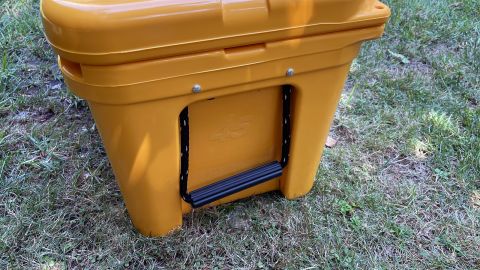
Even examining the smallest design elements, you never feel like Yeti was ever trying to cut corners or use an inferior part to save money: every piece of this cooler feels sturdy and well-made. For example, the non-skid feet on the base of the cooler—a feature I never really put much thought into—are extremely “tacky” and made of a high-quality rubber, which will come in handy if you plan on using it on a slippery boat deck or truck bed. Other, cheaper coolers also boast about their non-skid feet, but upon close inspection, these were cheaper, more plasticky, and generally of lower quality than those used on the Yeti.
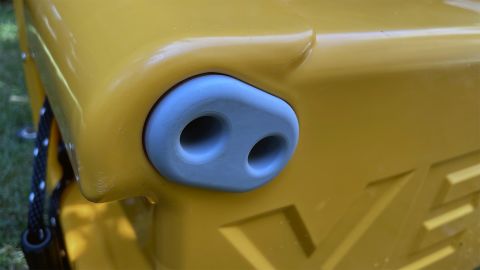
I found this same difference examining other fittings and elements as well, like the thick rubber latches that were easy to grab onto and stretch into place, and the sturdy, heavy-duty rope handles.
Perhaps most importantly, the Yeti Tundra 45 also retained temperature extremely well. It’s rotomolded body, three inches of Permafrost insulation and tight lid seal resulted in a 35.4 degree interior after my 2-day temperature test, with plenty of ice still intact. The smooth plastic interior is easy to wipe down when it’s time to clean, and a groove in the floor directs water toward the drain, so you don’t need to stand there and tip one end up while it empties. I do wish the drain plug was attached in some way though, since it could get lost or misplaced if you’re not careful.
The Yeti’s 45 quart size strikes a convenient balance between capacity (it holds 28 cans, or enough food and drink for an outing for several people) and portability (it’s small enough for a single person to lift and carry). If you do need a helping hand, the rope handles are perfect for that, providing a textured and sturdy rubber grip that makes it easy for two people to maneuver the Tundra. Or, if you prefer a little more control, another set of handles molded into the side of the cooler itself are a great alternative.
The included dry goods basket allows you to suspend food items above the ice to keep them from getting soggy, and the padlock holes allow you to easily keep nosy bears — or campsite neighbors — out of the cooler when you’re not around.
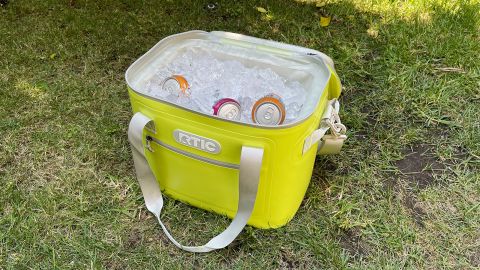
What makes the RTIC Soft Pack 30 the best soft-sided cooler I tested, was the fact that even though it had all the benefits of soft-sided coolers — light weight, compactness, and ease of carrying — it also provided the durability and heavy-duty components found on hard-sided models. This compact cooler is deceptively spacious too, with enough space for up to 30 cans and ice.
We put this cooler through the wringer during testing, filling it up and tossing into the trunk of my car, dropping it on the ground, and even swinging it around by the strap to stress-test the construction. Not only did the nylon shell, stitching, zippers, and straps hold up to the abuse, the Soft Pack 30 also didn’t spill a drop of water. The “puncture and tear-resistant liner” definitely worked as advertised.
This leak-proof feature does come at a cost though, as its tight zipper and rubber seal does take a decent amount of effort to open and close. I felt that this was a reasonable trade-off—especially after a cheaper cooler leaked all over my backseat—and RTIC makes it less of an issue with large, t-shaped pulls and an included tube of zipper lubricant.
I also appreciated the variety of carrying options on the RTIC Soft Pack 30. You get a shoulder strap, a top handle, and two side handles that make it especially convenient for moving around while the lid is unzipped. This top carrying handle was especially comfortable to use and ideal for one-handed use. And since it’s connected to the body of cooler itself — not just the lid as on the Igloo we tested and some other common soft cooler designs — it should be durable enough to last a long time. A zippered pocket on the front of the cooler was a nice perk too, and could be perfect for keeping your bottle opener, or cash and credit cards when you’re at the beach.
While The RTIC Soft Pack 30 maintained an interior temperature of 32.1 degrees Fahrenheit for 24 hours, the long term temperature retention of the RTIC Soft Pack 30 wasn’t the greatest — it started creeping up after 36 hours, reaching 48.9 degrees after 48 hours—so it is best suited for an afternoon trip to the beach, a day hike, or afternoon BBQ. This was in line with the rest of the soft coolers we tested, which all began to lose their cool between 24 and 36 hours.
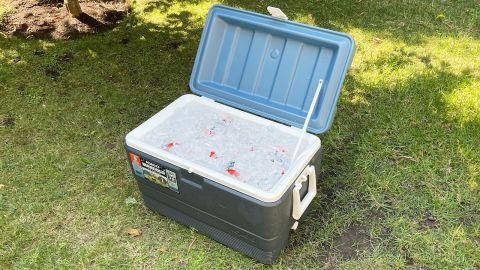
If you’re just looking for a bare-bones, basic cooler to plop down on the beach or backyard for the day, there’s absolutely no reason to spend hundreds of dollars on a high-end model. This Igloo cooler might not provide the durability, waterproof design, or slick appearance of the Yeti or Pelican, but you know what it can do? Hold a ton of cans and keep them cold. And you can sit on it.
It also retains temperature extremely well. I was surprised to see that after 48 hours this cooler had maintained an interior temperature of 33.2 degrees, (that’s actually three degrees colder at that point than the Yeti Tundra 45). The injection-molded walls are thinner than fancy rotomolded construction, which allows the MaxCold to offer an impressive amount of storage, despite its relatively small footprint, with a 50 quart interior and capacity of 72 cans.
Even though some of the Igloo’s components don’t seem built for the long haul — the hinges and plastic latch are a little flimsy — the handles are sturdier than expected, and although a little thin, were comfortable to use and didn’t take up much space. The lid is really beefy, and made sturdy enough to serve as a seat or step stool, something that is not the case with many low-cost coolers. A plastic strap keeps the lid from falling backward when you open it too, which should help extend the lifespan on those plastic hinges.
My absolute favorite feature of this cooler was the drain plug. Unlike some cheap coolers that use a “friction plug” that stays in place by just pressing it into the drain (and are a disaster waiting to happen), the Igloo MaxCold 50 Quart uses a threaded plug that you screw in and out for a tight, secure seal. Plus, it’s designed with a strap to stay connected to the cooler at all times, so there’s no danger of it getting lost while draining.
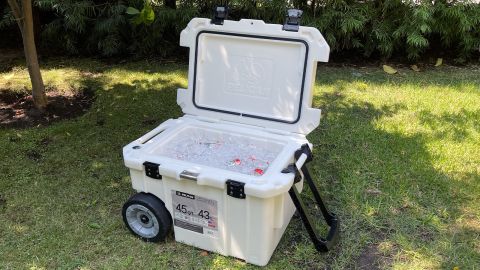
This wheeled cooler from Pelican is built like a tank, and if your future plans include activities or adventures that could damage a lower-quality cooler (or you need to haul loads too heavy for you to carry comfortably), the Pelican Elite 45 might be just what you need.
Every part of the Pelican Elite 45, from the wheels to the drain plug to the handle has a beefy, heavy-duty feel that gives you the confidence that this thing can handle whatever you throw at it. (According to the Interagency Grizzly Bear Committee, that includes grizzly bears).
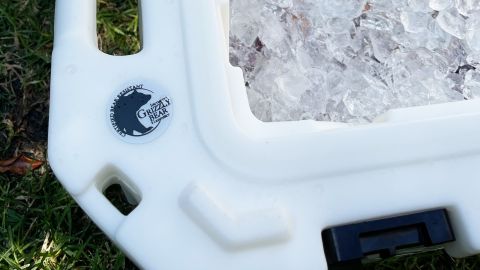
Wheeled coolers are notorious for either being a pain to use and steer, or too cheaply made to last very long, so what really made this the best of the wheeled coolers is that, despite the rugged appearance, it was extremely easy to maneuver, even when totally full of ice and drinks. The wheels have a molded tread with a rubber coating that made them much more stable than the plain plastic versions used by some of the competition.
Even better, the simple design of the trolley handle — it’s made of a single piece of heavy-duty plastic, rather than a telescoping handle with small components and extra moving parts as on some competitors — makes it extremely durable and practically indestructible. It never gets stuck under heavy loads like some telescoping designs can, and even when fully loaded, I never felt that this handle or the hinge connecting it to the cooler was ever in danger of cracking or breaking. When you’re done pulling, just fold it down and it’s out of your way.
The Pelican Elite 45 had by far the best drain plug of all the coolers we tested. Not only is the cap nice and bulky, making it really convenient to grab and twist, but a wire tether keeps it connected to the cooler at all times. A recess inside the cooler directs the water towards the drain too, so there’s no need to tip the entire unit when emptying it out.
Most importantly, it does a great job of keeping things cool, hoklding its temperature really well, and topped out at just 32.7 degrees after two days.
We understand that the high price tag may be a turn-off for some, but after testing several lower cost wheeled coolers and finding that cheaper materials and worse design made them mroe frustrating to use, we think the investment could be worth it if you think you’ll use a wheeled cooler regularly
We found two big differences between the hard and soft coolers we tested. First is their weight. Since they’re typically made of fabric or vinyl, soft coolers are practically weightless compared to hard coolers. This makes soft coolers ideal for smaller tasks — carrying a 12-pack to a picnic versus schlepping a weekend’s worth of food and drinks for a camping trip —, since their shoulder straps and handles allow you to use them one or no-handed.
The other main distinction is that the thinner fabric construction of soft coolers makes them less effective at retaining temperature. While the hard coolers we tested were able to keep food at safe temperatures for two days or more, all of the soft coolers — including the highest-quality models — were only able to maintain refrigerator temperatures for around 24 hours. We don’t think this is a dealbreaker since their capacity makes them best suited to smaller loads and thus shorter outings, but if you’re looking for maximum versatility a soft cooler may not be optimal.
Accessibility is another factor to consider. Hard coolers have lids that are relatively simple to open up when you need to get inside, while soft coolers almost always have a zipper to keep them closed. This might not be a big deal if you’re using a soft cooler for it’s portability, but if you’re at a tailgate or BBQ, popping the lid on a hard cooler is just easier and more convenient. Also, since soft coolers don’t have drains, they are less convenient to clean up once the ice melts.
I will say that if you plan on getting really dirty, like on a fishing or hunting trip, hard-sided coolers are much easier to clean. When you’re cleaning fish or game, its much easier to quickly scrub or hose-down a hard plastic cooler than one with a fabric shell and flexible inner liner. Plus you can use most of them as a seat while you’re working or relaxing.
First, chill the cooler before you pack it if possible. Tossing a bag or two of ice inside for an hour to two will cool the interior and add some extra time to its overall cooling time. If you can’t pre-chill, at least try to avoid packing a hot cooler — don’t leave it in the garage or in the sun beforehand.
When filling your cooler, try and keep a 2:1 ratio of ice to food/drinks. Since cold air and water will sink, you don’t want to add any ice first. Shoot for a layer of food or drink, then a layer of ice, and so on until your cooler is full. Do your best to not leave air pockets as you go, so feel free to shake and shift you cooler to help the ice cubes settle into any dead space.
Frozen ice packs will stay colder longer than ice cubes, but their shape and size can sometimes result in air pockets if you don’t arrange them carefully. If you have both options, use the ice packs as well as loose ice cubes to cover all your bases. Finally, try and not drain any melted ice water if you don’t have to. It’s most likely going to be colder than the air it will be replaced by, and will continue keeping the temperature as low as possible.
Regardless of how well you pack your cooler, the temperature will eventually fall below safe levels for food safety. If you’re storing perishable foods, the USDA recommends keeping an appliance thermometer inside the cooler, and making sure it reads 40 °F or below. They also advise that if the outside temperature is over 90 degrees — think beach trip or summertime barbeque — you should, “put perishable food back in the cooler within 1 hour after eating. Otherwise, cool it within 2 hours”.
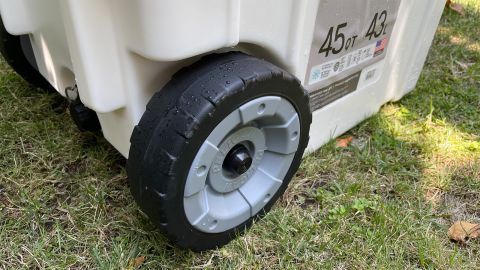
That depends on how far you’re going to be transporting your cooler, and the amount of weight you’re comfortable carrying yourself. A full cooler can be extremely heavy — the 45 quart coolers we tested weigh from 23-29 pounds empty, and can hold 40 pounds or more of ice and food — and even if you’re strong enough to carry it yourself, it’s no fun to huff and puff your way across a parking lot or down a trail if you don’t have to.
If you’re pulling your car right up to a tailgate and setting up for the day, or camping at a drive-up site, even a big cooler can be manageable without wheels. But if you’re traversing a parking lot at the beach, or even a long driveway on the way to a friend’s barbeque, a wheeled cooler can really come in handy. Plus, wheeled coolers usually have carrying handles as well, so you won’t have to choose one over the other.
If you do choose a wheeled cooler, try and go with a durable, high-quality option. While basic, non-wheeled coolers can get away with using thinner, flimsier components, that kind of light-duty construction isn’t going to fly when it comes to wheeled models.
Why are rotomolded coolers so expensive and heavy? And are they worth the extra money?
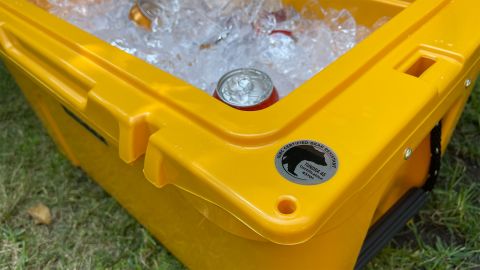
You probably see the term “rotomolded” tossed around in high-end cooler descriptions, but aside from it indicating the heavy, high-quality plastic used in Yeti, RTIC and similar coolers, you may not have seen a clear explanation of what that really means.
Rotomolding (short for rotational molding) is a manufacturing process in which molten plastic is poured into a mold, and then rotating the mold as it cools to allow for an even coating, especially around the corners and edges. This results in a thick, consistent layer of plastic without seams or stress points, and is why rotomolded coolers are so durable, and it creates a smoother, more premium-looking surface. But all of that extra plastic makes rotomolded products (like high-end coolers) significantly heavier.
As for the expense, while rotomolding is slower and more expensive per part, it isn’t the sole reason that makes Yeti, ORCA, RTIC and other rotomolded coolers so expensive. Typically these coolers are much more heavily insulated than everyday models and have fancier fittings, hinges, handles and so forth, all of which adds manufacturing cost, plus the companies that make them back them with long warranties.
But like many high-end products, rotomolded coolers are expensive to some extent mostly because they’re made in smaller numbers and marketed as premium items — and people are willing to pay more to get the best, highest performing products, even if they’re not going to use them in the backcountry.
Injection molding — the process by which many less expensive coolers are made — involves injecting plastic under pressure into a mold. This uses less plastic overall, and results in a lighter product, but at the expense of strength and durability.
That’s not to say that injection molded coolers are inferior, they just won’t have the durability of a rotomolded option (Though when done cheaply, injection molding can also result in inconsistent coverage, and thinner corners and edges). Injection molded coolers can be made to perform extremely well (and indeed our budget pick kept things cold for the weekend just as well as the most expensive options we tested).
But if you don’t need an indestructible cooler that will survive being strapped to the outside of an off-road vehicle on a multiday gravel road expedition, non-rotomolded coolers are a perfectly fine—and much lighter—option.
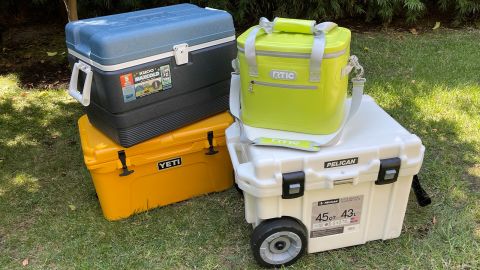
Since most cooler brands use the same vague terms like “long-lasting ice retention”, “superior insulation” and “high performance,” we put each of our 17 coolers through a comprehensive series of tests to help you get a clear understanding of what really makes them different from one another.
Since the goal of your cooler-based activity is most-likely relaxation, it’s important that they’re easy to use. The last thing you want is to hassle with a top-heavy cooler that tips over too easily, a lid that requires significant effort to yank open, or an unnecessarily heavy model that isn’t convenient to transport. I did my best to run each cooler through a general, hands-on usability evaluation, where I tested every feature, component, and accessory, making note of any issues I came across. I paid close attention to the maneuverability and steering capabilities of wheeled coolers, judging how well they traversed different environments like pavement, grass, gravel, and sidewalk curbs. When it came to soft-sided coolers, I loaded them up and tested out how comfortable their shoulder straps and other carrying handles were to use, as well as how they held up to the stress of being tossed around, lifted up, and “accidentally” dropped.
To accurately judge how well each model kept its temperature, I filled each cooler with ice and its recommended can capacity, closed the lid, and placed it outside for 48 hours. Using a bluetooth thermometer inside the cooler, I logged each model’s temperature throughout the trial, and when I was finished, was able to easily compare each cooler’s temperature retention capability.
The overall build quality of the coolers was a major testing focus as well. I carefully inspected and evaluated the durability and sturdiness of each cooler and its parts, taking notice of any models that felt flimsy or of low-quality, looking out for parts or design elements that would be likely to break down or crack over time. This included latches, handles, hinges, wheels, straps, zippers, drain plugs and accessories like bottle openers and dry-good baskets.
In addition to these categories, I also took overall weight, size, ease-of-cleaning, warranty, and water-resistance into account when comparing similar options.
A close runner-up to the Yeti Tundra 45, this 45-quart rotomolded cooler looks nearly identical, though it costs about $100 less. Although it did keep the temperature at 35.4 degrees (the same as the Yeti), it is 6 pounds heavier, which could add up if you plan on carrying it frequently. The foam handles also seemed a bit less durable than the Yeti’s rubber versions, and the non-slip feet were less “tacky” and thus less effective. These definitely aren’t dealbreakers, and if you’re set on a rotomolded cooler I’d consider the RTIC 45 a great lower-cost alternative to our top pick.
Another hard-sided model similar to the Yeti Tundra 45 and RTIC 45, this ORCA cooler boasted a heavy-duty rotomolded construction, thick rubber latches, and rubber and strap handles that I found to be really comfortable to use. Unfortunately, it was heavier and significantly bulkier than the Yeti and RTIC, and also performed slightly worse in my temperature test, reaching 37.7 degrees at the end of the 48 hour period, plus it costs as much as the better-performing Yeti Tundra 45 (and $100 more than the RTIC 45). It did offer an accessory that neither of its competitors did, a removable mesh cargo pocket, screwed into the exterior of the cooler, which can be handy for non-refrigerated items.
The smallest hard-sided cooler in our test, this 20-quart ORCA model features a rugged rotomolded body and enough room to carry 18 cans with plenty of ice. The wide, top-mounted handle and cushioned foam grip was comfortable to use, and swings conveniently out of the way when it’s time to open the lid. It’s important to note that without any side handles, this design might not be ideal for everyone — especially considering that it already weighs 18 pounds before being filled — and could be too heavy for a single person to carry one-handed.
I love the old-school look of this budget-friendly cooler, and its 7.3-pound weight makes it by far the lightest of the hard-sided models in our tests. Unfortunately, this lightweight design translates to a flimsy product that won’t be durable enough for heavy-duty use — the lid even flexed and bent when I sat on it. That said, it fared much better than expected in our temperature retention test, rising to just 38.3 degrees after 48 hours outside. It likely won’t last forever, but if you just need a basic cooler for an outing and don’t want to spend a ton of money, it could be a great choice.
This Pelican model delivers the durability and functionality you expect from a high-end cooler, making it great for hauling along to any outdoor adventure. As with the wheeled 45 quart version, little details make for easy use and cleaning — the drainage channels molded into the cupholders prevent standing water from accumulating (something I experienced during my outdoor testing). We think you’d be better stepping up to a 45 quart model if you want to go with a rotomolded cooler, however — the 30 quart capacity seems just a little too small to justify its bulky size and weight.
Essentially a big, waterproof duffel bag, this soft-sided cooler from AO would be a great choice for those who want something lightweight, but with lots of room for food and drinks (it advertises a 49 can capacity). Its massive 30-inch zippered opening makes it really easy to dump in bags of ice without spilling everywhere, which is sometimes the case with more compact soft-sided options. It didn’t perform particularly well in our temperature test though, reaching 49 degrees after 48 hours, so like all of the soft coolers we tested it’s better suited to single-day adventures.
Similar in design to the AO Cooler, this duffel-bag-style cooler provides a wide zippered opening, perfect for quickly dumping ice bags. Heavy-duty side clasps secure the corners while you carry it around, considerably shrinking the length to a more manageable size. The flexible, fabric-like liner on the inside isn’t the easiest to wipe down in the event of a spill though, although it’s leak-proof design is a fair trade-off. It’s 1-inch insulation was a 1/4-inch thicker than the AO Cooler, and seemed to make a difference, holding the temperature to just 42.7 degrees after 48 hours.
This backpack cooler from Yeti is extremely well-made, and the straps, exterior shell, clasps, and rubber bottom stood up well to the abuse I dished out in my testing. The side handles were especially useful for moving it around, and a useful alternative to the backpack straps. It’s vertical shape did make it a challenge to actually access the interior though, and if you wanted an item at the bottom you might find yourself digging around for a bit. The extremely high price relative to other soft models is likely to be a drawback, but if your priority is hands-free portability and you want a premium cooler, it could be a good fit.
Although this model from Igloo is technically soft-sided, it has a relatively solid structure, and is roomy enough to hold 30 beverage cans. At just 3 pounds, it’s also lightweight, and the shoulder strap made it easy to carry and transport. Its zipper was stiff though, more-so than the RTIC Soft Pack 30, so the similar t-shaped zipper pulls were definitely necessary. We didn’t love the top handle, however, which is attached only to the lid itself — we felt that over time heavy loads carried this way would stress the zipper. We preferred the strap design used on the RTIC Soft Pack 30 and other premium soft coolers, where the top handle is anchored to the cooler body rather than the lid. The Igloo 30 was, however, the best raw performer among the soft coolers, so if you’re not likely to carry it around it is absolutely worth a look: it kept its interior temperature better than any other soft-sided cooler, reaching only 38.2 degrees after 48 hours.
I wanted to like this cooler, but its design and construction doesn’t justify the high price. While the rubber latches were easy enough to use, and the wheels and carrying handles appeared to be of decent quality, the large trolley handle just wasn’t up to par with the Pelican. The plastic connection to the cooler was just too flimsy, and the weight of the full cooler caused the hinge to flex and bend as if it was going to pull itself off, making it more difficult to maneuver loaded than our top pick. That said, it did retain temperature exceptionally well, rising to just 32.1 degrees after 48 hours.
This wheeled cooler is everything you’d expect from a Yeti product: a heavy-duty rotomolded body, sturdy latches and impressive 48-hour temperature retention (32.7 degrees). It also includes a ton of useful accessories, like a divider for separating food items, three reusable ice packs, and a dry goods basket. Its vertical design also gives it a relatively small footprint, and allows you to store taller items like wine bottles or 2-liters. Although its telescoping handle was by far the sturdiest and well-made of all of the models we tested (as you’d expect from the premium price), I felt that the single-piece design of the Pelican Elite 45 handle was just better suited for wheeling around.
The low price of this cooler is certainly appealing, but we think you should spend a bit more (or stick with a cooler without wheels if you’re looking for something very inexpensive). The flimsy telescoping handle, hollow, thin wheels, and limited sealing (there’s no seal on the lid, so meltwater pours out when you tip it over to wheel it around). It does provide a ton of storage space inside, however, and only reached 37.1 degrees inside after 48 hours, which is pretty good at this price.
This Igloo cooler was the best of the low priced wheeled models we looked at, and while it isn’t going to stand up to abuse and wasn’t as easy to maneuver loaded as the pricier wheeled coolers, it will do if you just want something for picnics and other less demanding uses. The cavernous interior can hold 56 cans, and the super light weight (7.2 lbs) makes it great for a single person to lift or wheel around. The lid doesn’t latch, however, and the tall shape makes it a bit top-heavy and challenging to steer with the loose and flimsy handle. It also lacks a drain, so getting rid of excess water won’t be very convenient.

